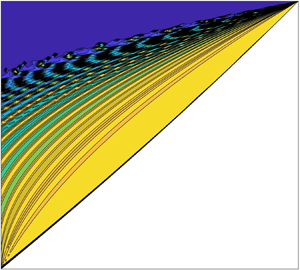Article contents
Enhancement of wave transmissions in multiple radiative and convective zones
Published online by Cambridge University Press: 31 March 2021
Abstract

In this paper, we study wave transmission in a rotating fluid with multiple alternating convectively stable and unstable layers. We have discussed wave transmissions in two different circumstances: cases where the wave is propagative in each layer and cases where wave tunnelling occurs. We find that efficient wave transmission can be achieved by ‘resonant propagation’ or ‘resonant tunnelling’, even when stable layers are strongly stratified, and we call this phenomenon ‘enhanced wave transmission’. Enhanced wave transmission only occurs when the total number of layers is odd (embedding stable layers are alternatingly embedded within clamping convective layers, or vice versa). For wave propagation, the occurrence of enhanced wave transmission requires that the clamping layers have similar properties, the thickness of each clamping layer is close to a multiple of the half-wavelength of the corresponding propagative wave and the total thickness of the embedded layers is close to a multiple of the half-wavelength of the corresponding propagating wave (resonant propagation). For wave tunnelling, we have considered two cases: tunnelling of gravity waves and tunnelling of inertial waves. In both cases, efficient tunnelling requires that the clamping layers have similar properties, the thickness of each embedded layer is much smaller than the corresponding e-folding decay distance and the thickness of each clamping layer is close to a multiple-and-a-half of the half-wavelength (resonant tunnelling).
- Type
- JFM Papers
- Information
- Copyright
- © The Author(s), 2021. Published by Cambridge University Press
References
REFERENCES
- 2
- Cited by





